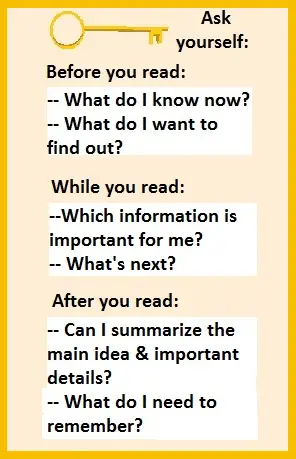English Reading Comprehension Strategies
English reading comprehension requires making connections between your experience or prior knowledge and what you read. So the best comprehension strategies (ways to improve your understanding of what you read) remind you of what you already know and think. They connect and compare it with the English text you are reading. They also focus your attention on what you want to learn from it.
After you read each chapter or section of text, use review strategies to summarize and evaluate what you have read. (Read a short section—just a few paragraphs-- if the text is difficult or if you need to analyze it well.) Then consider which parts you want to remember and make a part of your thinking.
English Reading Comprehension:
Strategies Before You Read

1. Think about what you already know or believe about the subject. This prepares you to make new links between nerve cells in your brain-- your “mind map”-- connecting what you will read with what you already think and know.
2. Think about what you need or want to get out of the reading. This helps focus your attention on what’s most important to you.
3. Scan the book or article’s title and headings, any pictures or graphs, and the introduction and conclusion. Look for the author’s main idea and make predictions. (What do you think the reading is about? What points will the author make?)
4. Think of specific questions you want to find answers for in this reading.
Comprehension Strategies While You Read
1. Skim the whole section first.
2. Adjust your speed & concentration level depending on need and type of material.
3. Use word decoding skills and context clues to figure out the probable meaning of an unknown word whenever possible. (For more information, see Reading Skills.)
If you are still doubtful about the word, ask yourself how important it is to understand its exact meaning. If you cannot understand the passage without it, then do look it up.
4. Try to visualize (see mental pictures) of what the author describes instead of silently translating the words into your first language.
5. As you read through the passage, look for answers to the questions you asked when preparing to read. Were your predictions right?
Check your comprehension by asking yourself more questions: Who is this talking about?What’s happening now? Where, when, and perhaps most important-— why? In a story, what does the character hope to gain by his or her actions? In a persuasive essay (or advertisement), what does the author want to convince you to believe or to do?
What is the author's main point? What feeling or reaction is he or she trying to create? If a word is surprising, ask yourself why the author chose that word or expression rather than a synonym? (English has many synonyms, but their connotations may be quite different. A particular word choice may change the feeling or implications of the whole section.)
6. Pay special attention to transition and sequence words, as they mark changes in direction and the order of events or of the author’s thinking.
7. To help you concentrate on (and remember) the main idea and other important points of the text, consider highlighting them, taking notes, or using graphic organizers.
Strategies to Use After You Read
1. Ask more questions to check your reading comprehension:
- Did I understand the author’s main point?
- Did I understand the other important things he or she was saying-- the examples he used, the conclusions he reached, the changes he recommends?
If in doubt, go back to the section you just read and skim it for answers to those questions.
2. As a review, mentally (or on paper, or with a study partner) summarize the main ideas of the passage. One way to summarize is with journalists’ “5 Ws & an H.” Ask yourself:
- “Who was this article or passage about? Or who were the main characters in this story?”
- “What happened? Or what is the main topic or idea expressed?”
- “When did this happen?”
- “Where did it happen?”
- “Why did it happen? (or what is the author's purpose in writing it?)”
- “How did it happen? (or how does the author want people to respond to what he has written?)”
3. Evaluate the passage: Was it accurate based on your knowledge of the subject? Was the author biased? (How?) What parts of his argument (if it was a persuasive essay) do you agree with? What do you see differently, and why? Were there facts or evidence the author didn’t consider? Do you agree with the author about what’s important, or would you emphasize something different?
4. Think about your reaction to what you just read. Did you enjoy it? Would you recommend this author or some of his ideas to others? How does what you’ve learned connect to what you already know? Will your reading change your perspective or plans?
Use these English reading comprehension strategies for each section of your book, chapter, or article.
If the words or arguments are difficult to understand, stop frequently to ask questions and summarize what you’ve already read. Look back over the section to clear up any confusion or to review what you don’t remember. Then predict what might come next. Read on, a little at a time, until you have read and understood the whole text.
Practice your English reading comprehension on the test and reading practice pages listed in Reading Strategies Practice or the other pages of EnglishHints.
Home>ESL Reading>Reading Comprehension Strategies.
Didn't find what you
needed? Explain what you want in the search box below.
(For example, cognates, past tense practice, or 'get along with.') Click to see the related pages on EnglishHints.
| site search by freefind | advanced |






New! Comments
What do you think about what you just read? Leave me a comment in the box below.